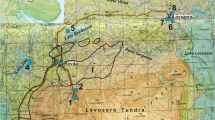Abstract
Based on previously obtained hydrochemical data on the reservoirs of the Moscow Canal, the Uglich, Rybinsk, Sheksna, Vytegra, and Belousovo reservoirs along with Lake Onega, thermodynamic calculations were carried out for the forms of the occurrence of trace elements in the waters of these basins. It has been shown that the prevailing forms were represented by free ions for Sr, Ba, Fe, Mn, Zn, Ni, Co, and Cd, fulvate complexes for Cu, as well as carbonate and fulvate complexes for Pb.


Similar content being viewed by others
REFERENCES
Alekin, O.A., Osnovy gidrokhimii (Foundations of Hydrochemistry), Leningrad: Gidrometeoizdat, 1970.
Allison, J.D., Brown, D.S., and Novo-Gradac, K.J., MINTEQA2/PRODEFA2, A Geochemical Assessment Model for Environmental Systems: Version 3.0 Users’ Manual, U.S. EPA, Athens, Georgia, 1991.
Campbell, P.G.C., Interactions between trace metals and aquatic organisms: a critique of the free ion activity model, in Metal Speciation and Bioavailability in Aquatic Systems, Tessier, A. and Turner, D.R., Eds., Wiley, 1995, pp. 45–102.
Gromova, V.A., Shestakova, T.V., and Lipatnikova, O.A., Ecological-geochemical evaluation of the state of surface water streams in the impact area of the tailing dump of the Urupsky ore mining, Moscow Univ. Geol. Bull., 2016, vol. 71, no. 6, pp. 407–415.
Gustafson, J.P., Visual MINTEQ, Version 2.30: A Windows Version of MINTEQA2, Version 4.0, 2004.
HCh: A Software Package for Windows. http:// www. geol.msu.ru/deps/geochems/soft/index.html. Cited June 22, 2020.
Johnson, J.W., Oelkers, E.H., and Helgeson, H.C., SUPCRT 92: A software package for calculating the standard molal thermodynamic properties of minerals, gases, aqueous species, and reactions from 1 to 5000 bar and 0 to 1000oC, Comput. Geosci., 1992, vol. 18, no. 7, pp. 899–947.
Kiryukhin, V.K. and Shvets, V.M., Opredelenie organicheskikh veshchestv v podzemnykh vodakh (Evaluation of Organic Matter in Underground Waters), Moscow: Nedra, 1976.
Komov, V.T., Stepanova, I.K., and Gremyachikh, V.A., The content of mercury in fish muscles from the reservoirs of the North-West of Russia: The causes of intensive accumulation and the assessment of the negative effect on the health of people, in Aktual’nye problemy vodnoi toksikologii (Actual Problems of Water Toxicology), Borok: Izd. IBVV, 2004, pp. 99–123.
Linnik, P.N. and Nabivanets, B.I., Formy migratsii metallov v presnykh poverkhnostnykh vodakh (Forms of Migration of Metals in Fresh Surface Water), Leningrad: Gidrometeoizdat, 1986.
Lipatnikova, O.A., Lubkova, T.N., and Yablonskaya, D.A., Approaches to water quality management in water supply sources (by the example of the Ivankovsky and Vyshnevolotsky reservoirs, Russia), in Proc. 16th Int. Multidisciplinary Sci. Geoconf. SGEM 2016. Vol. 3: Water Resources. Forest, Marine and Ocean Ecosystems, Sofia, Bulgaria: “Alexander Malinov”, 2016, pp. 35–42.
Lipatnikova, O.A., Lubkova, T.N., and Khavina, E.M., Hydrochemical characterization of aquatic formations of the Moscow Canal and the Volga–Baltic System, Moscow Univ. Geol. Bull., 2021, vol. 76, no. 1, pp. 68–76.
Mantoura, R.F.C., Dickson, A., and Riley, S.P., The complexation of metals with humic materials in natural water, Estuar. Coast. Mar. Sci., 1978, vol. 6, pp. 383–408.
McDonald, D.G. and Wood, C.M., Metal bioavailability and mechanism of toxicity, in Proc. 14 Annu. SETAC Meet., Texas, Houston, 2001, pp. 23–27.
Metody geokhimicheskogo modelirovaniya i prognozirovaniya v gidrogeologii (Methods of Geochemical Simulation and Prediction in Hydrogeology), Krainov, S.R., Ed., Moscow: Nedra, 1988.
NIST Critically Selected Stability Constants of Metal Complexes Database: Ver. 8.0. https://www.nist.gov/srd/ nist46. Cited March 5, 2020.
Nordstrom, D.K., Modeling low–temperature geochemical processes, Treatise on Geochemistry, Holland, H.D., Ed., vol. 5. Amsterdam: Elsevier Pergamon, 2004, pp. 37–72.
Nordstrom, D.K. and Archer, D.G., Arsenic thermodynamic data and environmental geochemistry, in Arsenic in Ground Water: Geochemistry and Occurrence, Dordrecht, Netherlands: Kluwer Acad. Publ., 2003, pp. 1–25.
Parkhurst, D.L., Kipp, K.L., Engesgaard, P., and Charlton, S.R., PHAST – A program for simulating ground-water flow, solute transport, and multicomponent geochemical reactions, U.S. Geol. Surv. Techniques and Methods, vol. 6-A8, 2004.
Schnitzer, M. and Scinner, S.I.M., Organo-metallic interaction in soil: 7. Stability constants of Pb, Ni, Co, Ca, Mn and Mg-fulvic acid complexes, Soil Sci., 1967, vol. 103, pp. 247–252.
Shvarov, Yu.V., HCh: New potentialities for the thermodynamic simulation of geochemical systems offered by Windows, Geochem. Int., 2008, vol. 46, no. 8, pp. 834–839.
Shvarov, Y., A suite of programs, OptimA, OptimB, OptimC, and OptimS compatible with the UNITHERM database, for deriving the thermodynamic properties of aqueous species from solubility, potentiometry and spectroscopy measurements, Appl. Geochem., 2015, vol. 55, pp. 17–27.
Stiff, H.A., The interpretation of chemical water analysis by means of patterns, J. Petrol. Technol., 1951, vol. 3, no. 10, pp. 15–17.
The Order of Ministry of Agriculture of Russia no. 552 of December 13, 2016 “On Approval of Water Quality Standards for Fishery Water Bodies, Including Standards for Maximum Admissible Concentrations of Pollutants in the Waters of Fishery Water Bodies (Registered by Ministry of Justice of Russia on January 1, 2017 no. 45203), Moscow, 2017. http:// docs.cntd.ru. Cited June 22, 2019.
Turner, D.R., Whitfield, M., and Dickson, A.G., The equilibrium speciation of dissolved components in freshwater and seawater at 25°C and 1 atm pressure, Geochim. Cosmochim. Acta, 1981, vol. 45, no. 6, pp. 855–881.
Varshal, G.M., Koshcheeva, I.Ya., Sirotkina, I.S., et al., Study of organic matters of surface waters and their interaction with metal ions, Geokhimiya, 1979, no. 4, pp. 598–607.
Funding
This study was supported by the Russian Foundation for Basic Research, project no. 19-05-00519 “The development of experimental and theoretical bases of quantitative colloidal geochemistry of continental waters.”
Author information
Authors and Affiliations
Corresponding authors
Additional information
Translated by A. Rylova
About this article
Cite this article
Lipatnikova, O.A., Lubkova, T.N. The Forms of Occurrence of Trace Elements in Natural Waters of the Aquatic Formations of the Moscow Canal and the Volga–Baltic System. Moscow Univ. Geol. Bull. 76, 215–222 (2021). https://doi.org/10.3103/S0145875221020058
Received:
Revised:
Accepted:
Published:
Issue Date:
DOI: https://doi.org/10.3103/S0145875221020058




